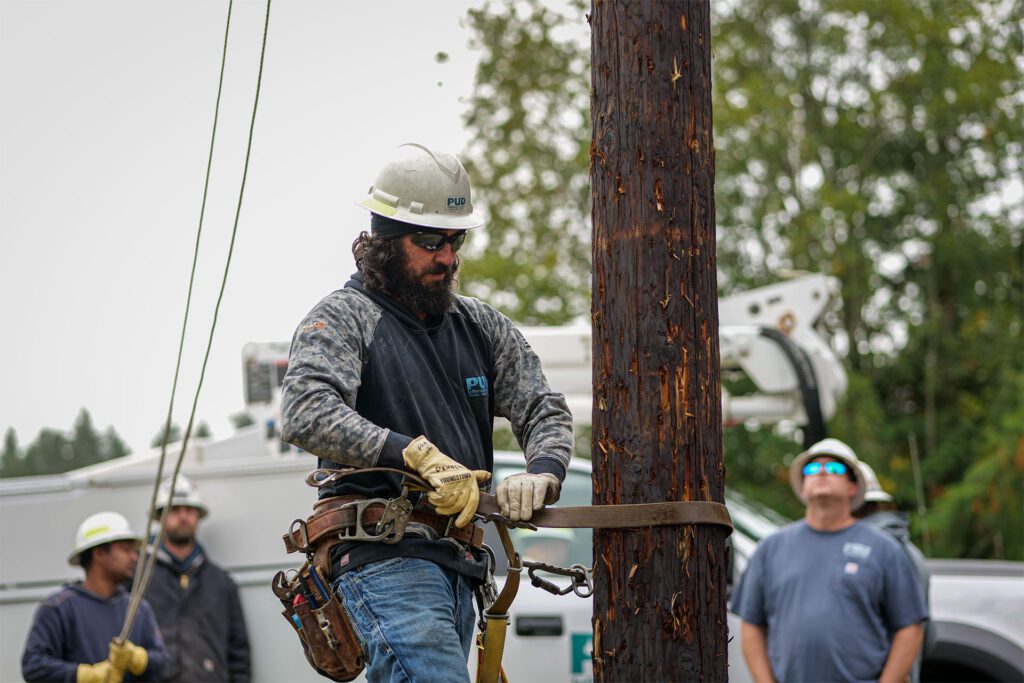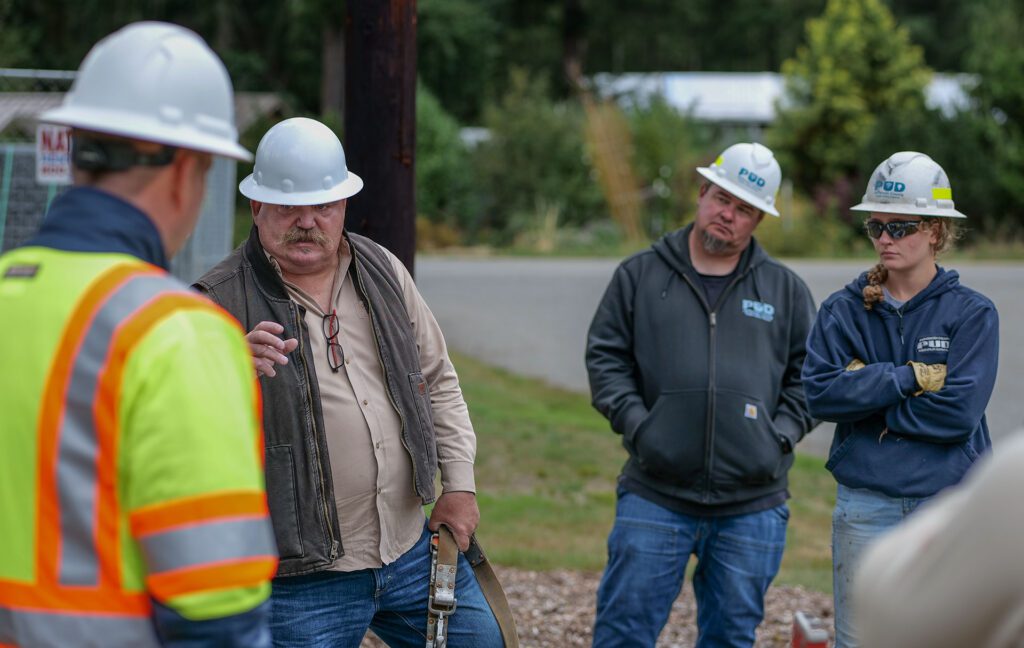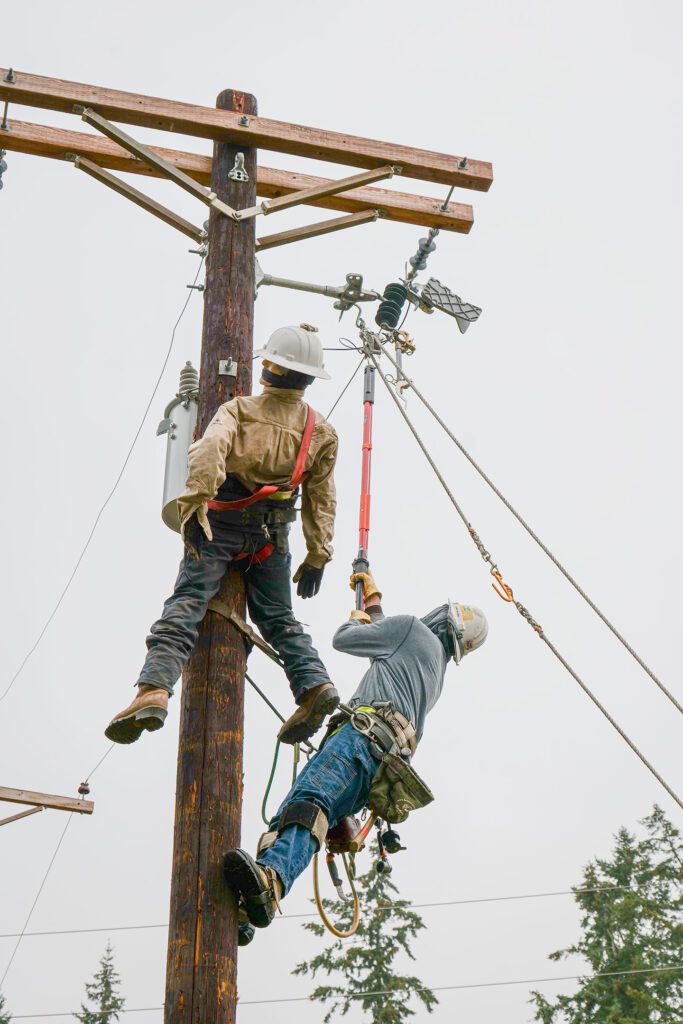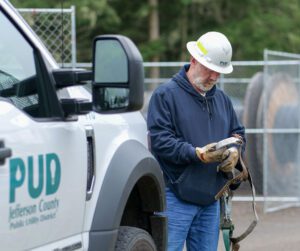Safety is on the Line
Line Foreman, Jonathan Dehnert wheeled around and pointed, “You, call 9-1-1 and grab the AED from the truck!”

Within seconds he’s slung the climbing strap around the base of the utility pole and leveraged his climbing gaff spikes into the sides and began climbing. Overhead, 20 feet in the air, a live weight dummy hangs limp by its safety harness–an eerie sight to behold from the viewpoint of passersby.
Dehnert arrives at the scene and quickly makes the area safe. The situation simulates an inadvertent contact between a line worker and a live voltage in the power space. Dehnert grabs the bright orange “hot stick” (an insulate pole designed to handle high voltage) and opens a cutout fuse device. He then begins rigging the lifeless body for a rapid descent via an improvised (practiced) belay by team members on the ground.

John Spain, safety instructor with Northwest Safety Service, looks on from ground level and narrates the action above to PUD staff as Dehnert reaches for his utility blade. “Coming down!” he yells. A quick swipe through the practice belt and the dummy is lowered gently to the ground. Less than 2 minutes has elapsed from moment Dehnert left the ground to help, and that is the goal. Every second counts.
Each member of the PUD line crew takes a turn rescuing the dummy, which is hoisted back into position by the bucket truck winch after each run up and down the pole.
Safety Above and Below Ground
Members of the utility line crew, broadband team, and metering staff are on hand for the training to glean valuable, life saving tips they hopefully will never need to put to practice. For realism, the PUD has an established a training space complete with practice poles for pole top rescue, a 6′ deep in-ground vault, and space for a bucket truck rescue.
Only line crew are certified to work in the power space, however the lessons taught on rigging and safely lowering someone from any height is invaluable. Below ground rescues present their own hazards.
 The scenario is equally troubling below ground: A team member falls into an open vault and is unconscious and incapacitated. For the passer by try to envision a 180lb person laying in pool of water 6′ underground in a space half the size of a standard closet. How do you get them out quickly and safely?
The scenario is equally troubling below ground: A team member falls into an open vault and is unconscious and incapacitated. For the passer by try to envision a 180lb person laying in pool of water 6′ underground in a space half the size of a standard closet. How do you get them out quickly and safely?
You improvise a gurney. Crew lower a fiberglass extension ladder into the vault, followed by a rescuer. Once inside, the rescuer rigs a rope to the ladder and under the arms of the “victim”, which is propped upward against the ladder. a few quick knots and the crew above ground are ready to pull.
“Make sure you support the legs,” Spain says as the team works to pivot the dummy up and out. “Ladders can catch on the edge of a sharp vault, so helping lift the legs takes some of the pressure off and also keeps them from sliding down again,” he added.
The Communication Space

PUD fiber staff also underwent elevated training with the truck-mounted bucket. The scenario is a team member is in the single-person bucket 20′ in the air and is unresponsive. The goal for the arriving crew is to select someone to call 9-1-1, then swing into gear by taking control of the bucket with the truck-mounted controls. Once lowered, the victim’s safety harness is unclipped and the bucket tilted to allow them to safely remove them to the ground.
The bucket rescues exercise is done with actual team members playing the victim which elicits a few good laughs all while the crew performs each step perfectly.
Long hours, adverse weather conditions, and physically demanding work environments require our staff to maintain a practiced approach to rescues, and trainings like this ensure our PUD field teams are ready for any circumstance.

